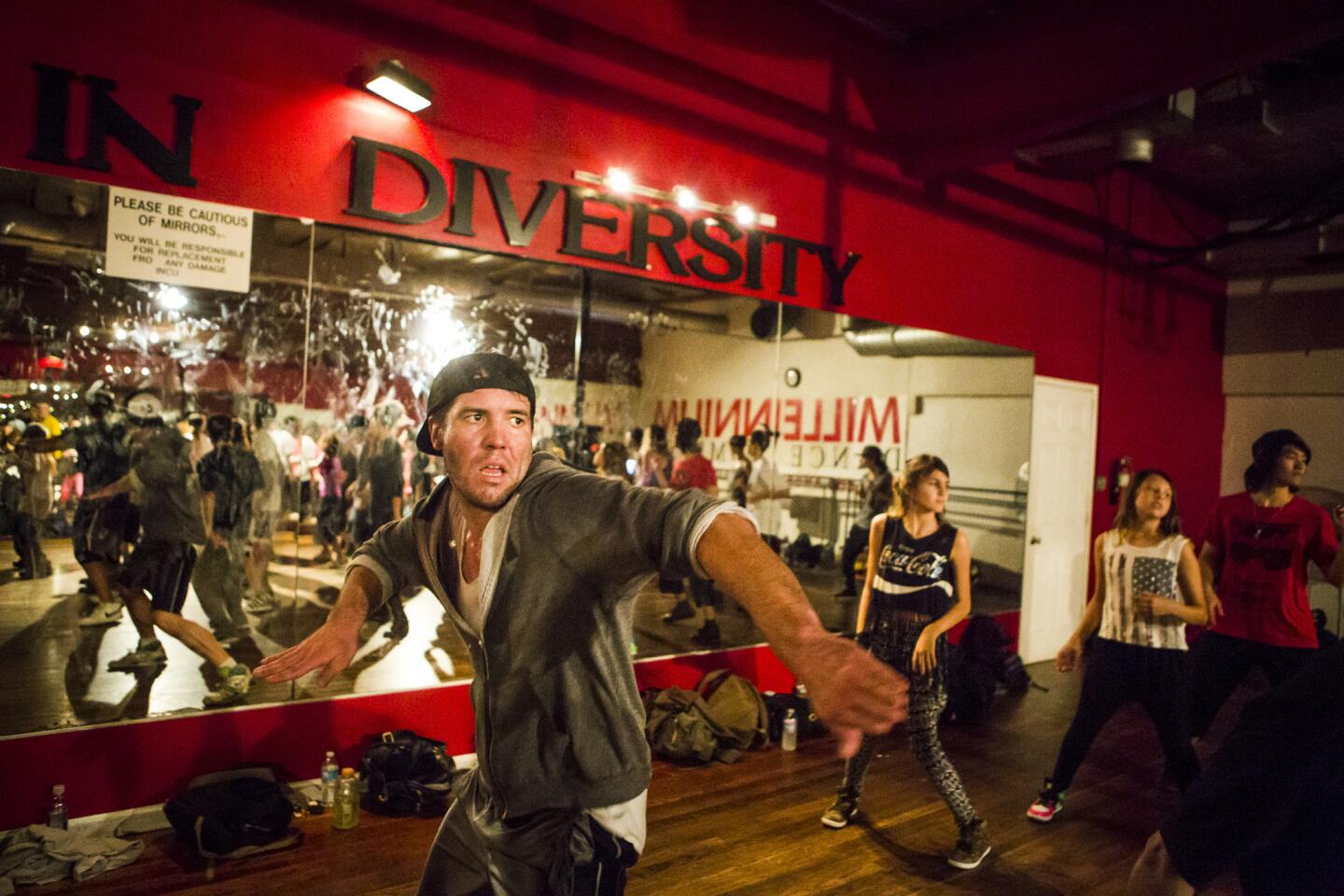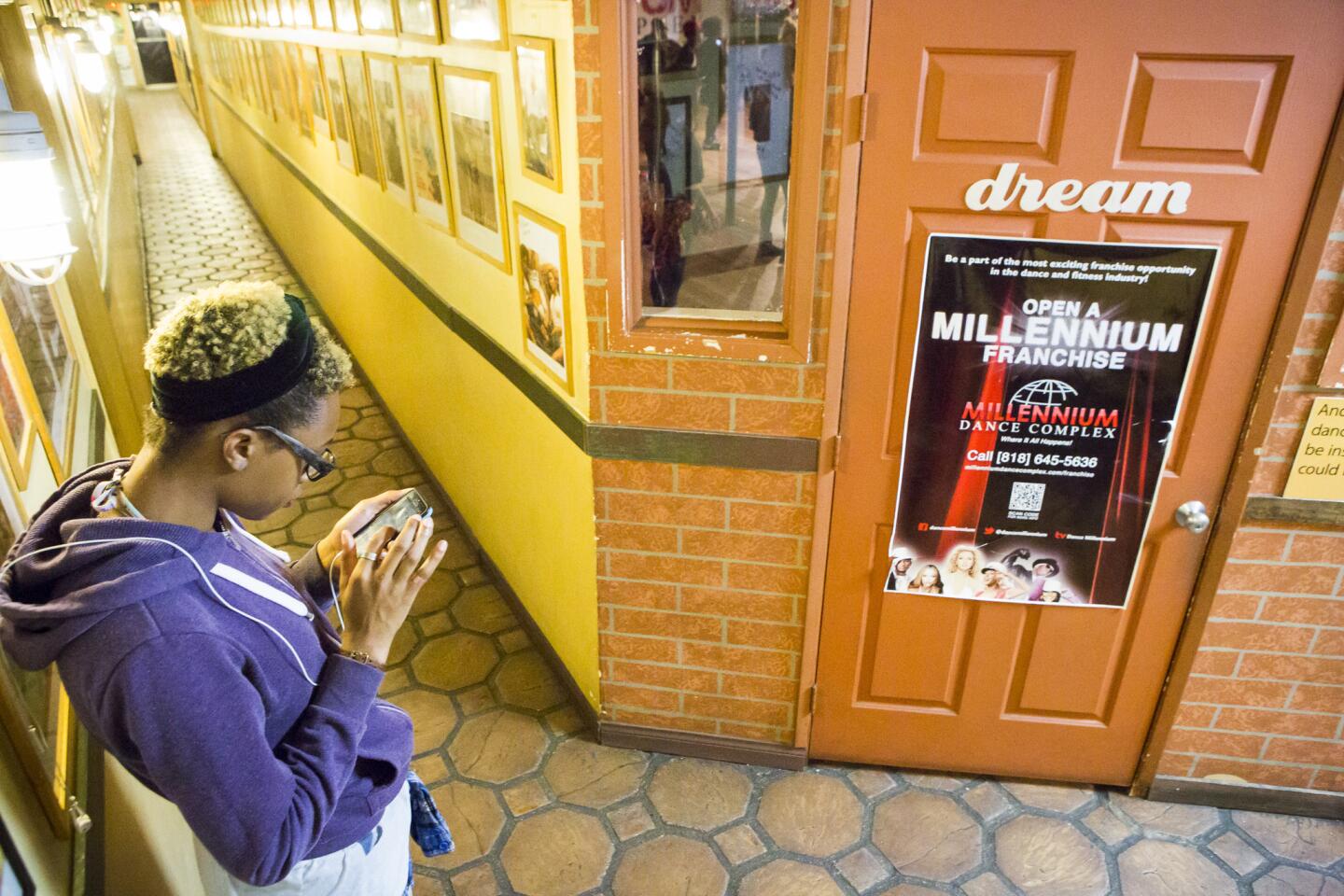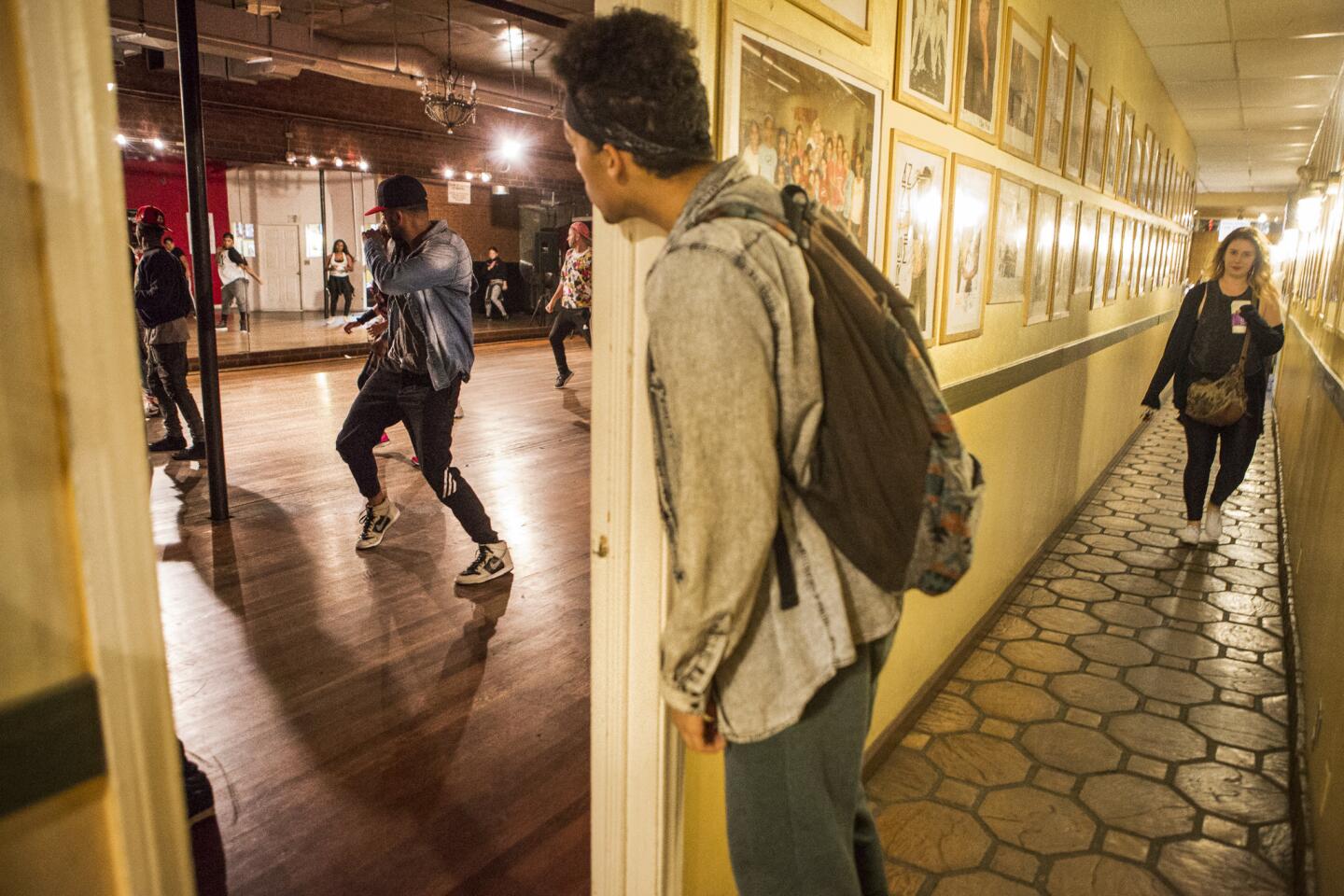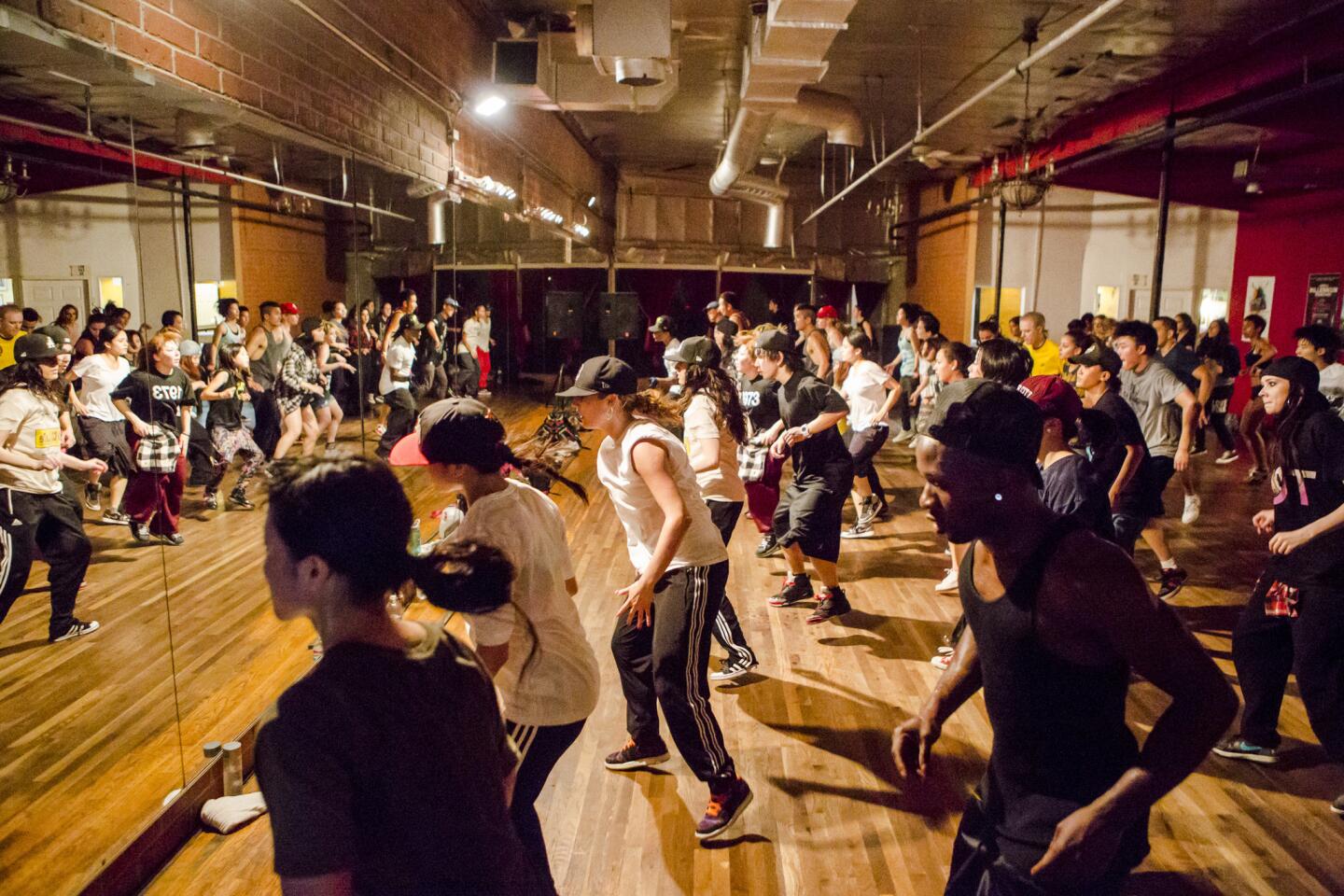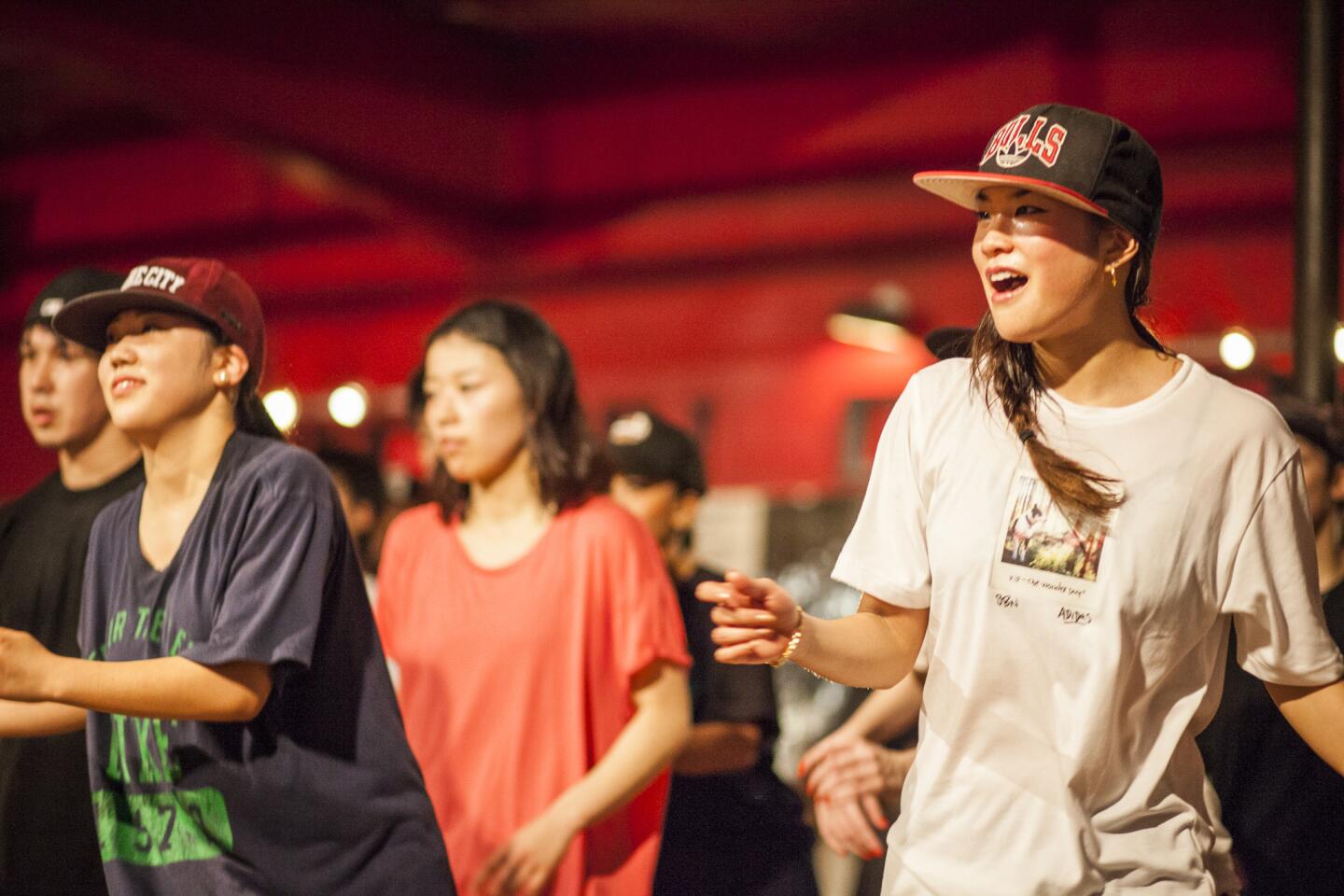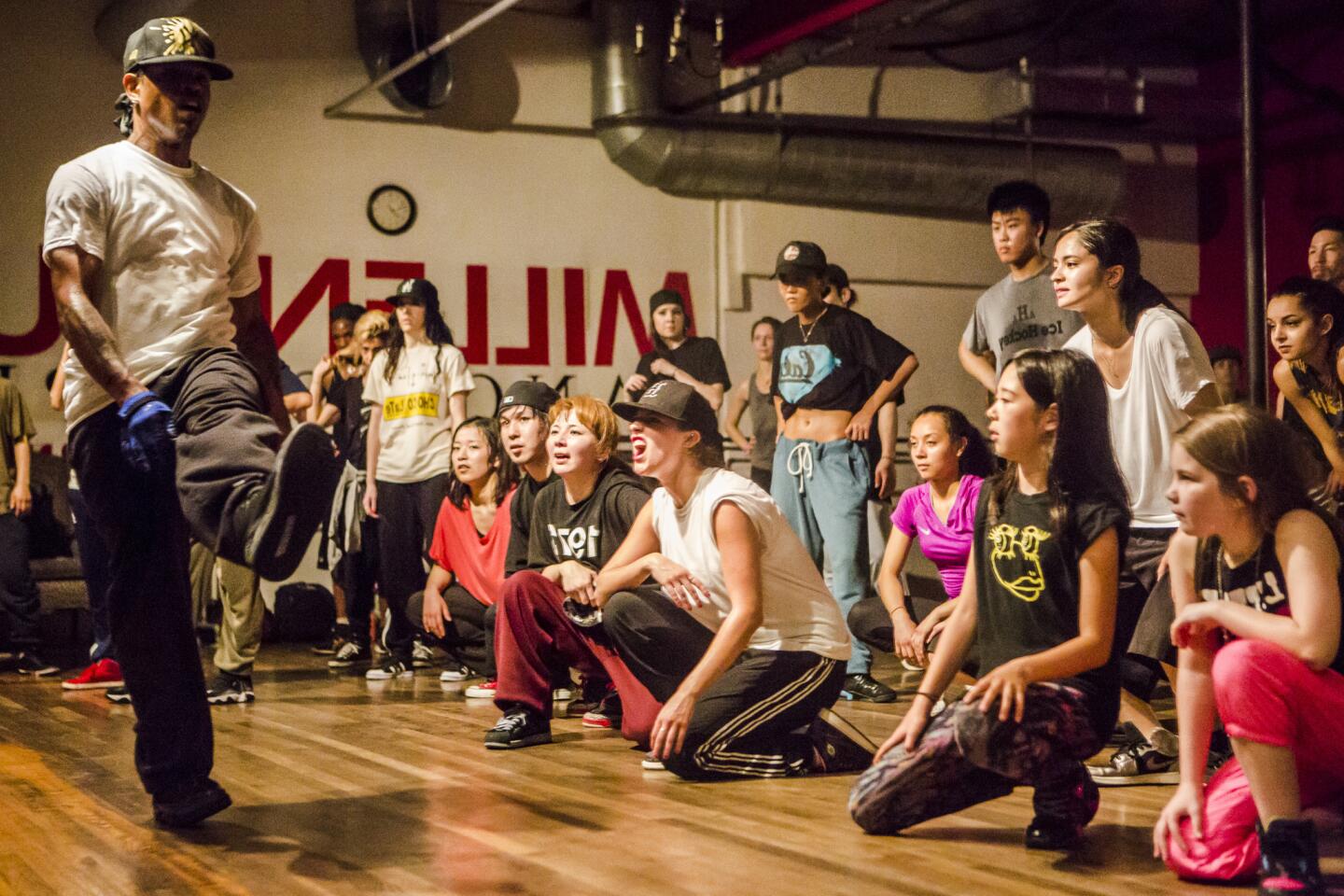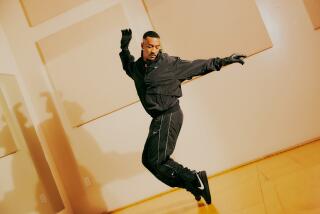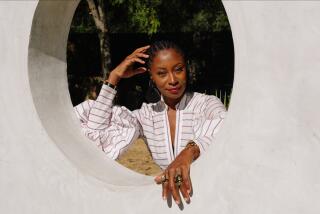Hip-hop moves from the street to the studio

Student dancers participate in an evening hip-hop class (house dancing) led by instructor Sho-Tyme at the Millennium Dance Complex studio in North Hollywood.
The sounds of music thumping and feet pounding to the beat reverberate from the mirrored studios inside a nondescript building in North Hollywood’s NoHo Arts District. This is the home of the Millennium Dance Complex, where on any given night the figure sliding up next to you might turn out to be Justin Timberlake, Janet Jackson or Jennifer Lopez.
“The best dancers in the world come to take classes from the best of the best teachers in the world,” says Marty Kudelka, who is Timberlake’s main choreographer. “It’s like a dancer all-star game, day in, day out. Everyone I work for loves it there. It’s discreet, professional and just has great vibes.”
Kudelka teaches at Millennium on a semi-regular basis. And Timberlake, when he’s in town, sometimes joins his choreographer’s class, testing the rhythms of new steps just like the aspiring hip-hop dancers in the room, although he may have had a bit of inside info on the routine.
“When they were rehearsing for the “20/20” tour, Justin popped in for dance classes that Marty was teaching,” says Jin Lee, vice president of operations at Millennium. “He’ll come in [wearing] a baseball cap and go sit in the corner of the room” before class.
The classes, Lee adds, “are a great way to train in the craft that you want to work in. But in L.A., it’s who you know — and here you get to meet the choreographers who are possibly hiring.”
Jackson and Lopez, for instance, have come to the dance studio not only to practice concert and video routines but occasionally to pluck talent from the practice floor.
For some, it’s their dream to come to Millennium and dance with their favorite choreographers.
— AnnMarie Hudson
“For some, it’s their dream to come to Millennium and dance with their favorite choreographers,” says AnnMarie Hudson, founder and co-chief executive of the dance complex.
Hudson learned early on about the power of choreographers, recruiting early star dancers like Wade Robson and Shane Sparks, who not only brought celebrity clientele but drew other dancers who were starved to learn new moves. She and co-founder Robert Patrick Baker opened the school back in 1992, when teaching hip-hop dance was not nearly as popular as it is now.
“It was mostly jazz and contemporary, so when hip-hop music started having lots of dancers in their videos, it was like, ‘Eh, where do you go to get them?’” Hudson says. “Many of the top hip-hop dancers would go to the top studios, but they were relegated to the small rooms. Even when their classes got huge, they were still looked down upon.”
“Studios were kind of snobbish,” Baker says. “You know, how golf was before Tiger Woods. It’s now become sort of a celebrity lifestyle brand. Most of our staff are working dancers and instructors and choreographers, and now even the backup dancers are stars.”
“We came because of YouTube, and because it’s part of the international dance community,” says a Danish dancer who traveled to North Hollywood for several weeks of classes with a group of 19 dancers from Copenhagen. “You see the Millennium sign in the background [of the dance videos] and you know that this is where it happens.”
Outside the studio, the Danish dancer, who gives her name only as Line before dashing into a car when an unexpected rainstorm hits, shares one quick insight into the Millennium style: “We’ve learned a lot in terms of picking up choreography,” she says. “In Denmark, it’s a lot slower. Whereas here, it’s step-step-step-step. We’ve gotten better in one month already, but it’s also not just the moves.” She and others in her group note that the encouragement and inspiration they’ve received from the teachers is also a big help.
Nietzsche greets visitors in the complex’s lobby with the words, “And those who were seen dancing were thought to be insane by those who could not hear the music.”
Down a hallway to one of the building’s many studios, signed photos of celebrity teachers, dancers, pop stars and actors, including Katy Perry, Britney Spears and Jennifer Love Hewitt, line the way, with still more motivational messages mixed in. Eleanor Roosevelt’s line “Where there is no art, the people perish” is prominent in a place that prides itself not only on the commercial prospects of being a dancer, but also on the art and history of hip-hop dance.
“What it takes to become a hip-hop dancer is first learning the hip-hop culture,” says Sho-Tyme, a teacher of general hip-hop and house, one of the many offshoots or sub-genres of hip-hop dance. “You have to know where it’s from — the origin of it. You have to learn everything inside of it, so that when the music is playing it’s automatic [in terms of] how you move to it.”
Like Kudelka, Sho-Tyme, who has choreographed for Jay Z, Mary J. Blige, Shakira and more, is one of Millennium’s many working instructors. Others include Super Dave (Usher, Chris Brown) and Bryan Tanaka (Rihanna), who teach the most contemporary steps and routines to the tune of $15 per student each class.
Many of the instructors also feel a duty to teach at least a rudimentary history of hip-hop dance to their captive attendees, who often may not know much about dance before Michael Jackson.
“One of the things that is unique and really cool about this studio is that not only do you have choreographers and teachers who have been on tour with Justin Bieber and all of that, but you also have people who possess full-on credentials in this culture, from the beginning of this culture until now,” says Dennis Danehy, an instructor at the studio and son of Don “Campbellock” Campbell, the creator of locking.
I’m going to teach you an eight count — that’s fine, but why are you doing the eight count? Do you hear the beat patterns in the song? A lot of the international students, they love it.
— Dennis Danehy
“People are accustomed to a fast-food everything,” Danehy continues. “They want it fast and quick, get in and get out. That’s not how we learned. We learned over a period of time and then lived it too. So to say I’m going to teach you an eight count — that’s fine, but why are you doing the eight count? Do you hear the beat patterns in the song? A lot of the international students, they love it.”
The international influx of dancers is helping fuel Millennium’s growth. Though they’re all practicing the same moves, different accents and languages hover in the lobby and private studios.
“Sixty percent of our business is international,” Baker says. “We get a ton of kids from Japan, and even from places like Slovenia. We get kids from all over Russia, Ukraine, Germany, France.”
Japan is such a huge market that Millennium sold a franchise there, Baker says, “before we even sold one in the States.”
In addition to Japan, Millennium studios in Pittsburgh and Salt Lake City have opened, and locations in Russia and India are also being discussed.
Despite the expansion, the local community is still the main focus of the complex. The NoHo arts scene has seen a resurgence of activity, and Millennium, which moved to North Hollywood from Studio City in 1999, is one of the area’s driving forces.
The dancers were already living there because it’s cheap and centrally located,” says Hudson. “They have to be in the studio at least a couple of hours a day to keep up and hone their craft.”
“Dance saved my life when I was younger,” Baker says. “We love it and we’ve seen a lot of lives being changed. It gives kids options instead of being in the streets. It’s a necessary thing and it transforms the person and the neighborhood.”
The explosion of dance, on television shows and in movies, has died down of late, but the influence of shows like “So You Think You Can Dance” and “America’s Best Dance Crew,” as well as movies such as 2013’s “Battle of the Year” and 2012’s “Step Up: Revolution” is still felt.
“ ‘So You Think You Can Dance,’ ‘America’s Best Dance Crew’ and the ‘Dancing With the Stars’ shows help us out, but they probably only feed about 40% of our business,” Baker says. “The bigger feed is the pop acts. You know, everyone wants to dance like Usher or Justin Bieber, and all those kids that are really big dance artists.”
So it’s back to being all about the dancers. The thumping sounds in the studios continue to reverberate as more students, including another international group, pile in to try some new moves. Some hope for a celebrity rendezvous, others are chasing a career dream. A few catch on quickly to the steps being taught, some stumble a bit, but all are determined to master moves they may have just tried for the first time.
“It’s like they’re movement tribes,” Hudson says. “It’s the language they speak — you don’t even have to communicate. Singers, you have to speak that language, but hip-hop is just music.”
Baker adds: “At the end of the day, if you can’t help people achieve their dreams in some form — well, that’s the whole point for us. Give them the tools they need to succeed.”
More to Read
The biggest entertainment stories
Get our big stories about Hollywood, film, television, music, arts, culture and more right in your inbox as soon as they publish.
You may occasionally receive promotional content from the Los Angeles Times.
